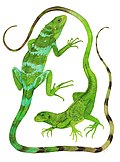Brachylophus fasciatus
| Brachylophus fasciatus | |
|---|---|

| |
| Lau banded iguana in captivity | |
| Scientific classification | |
| Domain: | Eukaryota |
| Kingdom: | Animalia |
| Phylum: | Chordata |
| Class: | Reptilia |
| Order: | Squamata |
| Suborder: | Iguania |
| Family: | Iguanidae |
| Genus: | Brachylophus |
| Species: | B. fasciatus
|
| Binomial name | |
| Brachylophus fasciatus (Brongniart, 1800)
| |

| |
Brachylophus fasciatus, the Lau banded iguana, is an
The species is
Taxonomy and etymology
This species was first described by French
This species is closely related to
Distribution and habitat
The Lau banded iguana is endemic to the Lau Islands of Fiji. Its recent range is known to extend from Vanua Balavu in the north to Fulaga and Ogea in the south, including at least eleven islands. Previously it was reported from Moce and Oneata, and it may have once been present throughout the Lau group.[1]
It was introduced to the
Description

Although there appear to be slight variations between insular populations, none have been well-described.[4] The animals from Tonga are smaller and leaner, and were previously described as B. brevicephalus.[4]
The skin of this species is sensitive to light and the lizard can change its skin color to match its background.[10] Captive specimens have been observed matching the pattern left by the screen tops of their cages in as little as 30 seconds.[10]
Behavior
The species is diurnal, spending their days foraging, basking and watching over their territories by day and retreating to the treetops at night.[4] Male iguanas are highly visual, and aggressively defend their territories from rival males.[11] The iguanas will deepen their green coloration to intensify their bands, and bob their heads and intimidate intruders by lunging at them with open mouths.[11] They often expand and flare their dewlaps to increase the size of their profile, following up with violent battles amongst each other.[11]
Diet
Fiji banded iguanas are
Reproduction
Courtship is similar to other iguanids, with males approaching and tongue flicking the female's back, forelimbs and
Relations with humans
Folklore
The Fijian name for iguana is "vokai", although some tribes call it "saumuri".[9] Two tribes regard the iguana as their totem and as such its name is not allowed to be mentioned in the presence of women or the offender may be beaten with a stick.[9] The majority of Fijians, however, are terrified of iguanas because of their behavior when threatened.[9] On such occasions, an iguana turns black, opens its mouth and lunges at attackers.[9]
Threats
The biggest threats this iguana faces is habitat loss due to fires, storms, agricultural development, and competition from feral goats.[9] A secondary threat is introduced predators in the forms of rats, mongoose, and cats which prey on the iguanas and their eggs.[9] Additionally the iguana has been hunted as a food source and for the illegal exotic animal trade.
Captivity
Since 1982 the Fijian government has maintained that the entire zoo population of Fiji banded iguanas was obtained illegally or descended from smuggled animals: "Virtually all of the estimated 50–100 banded iguanas in American zoos have been obtained without the knowledge or consent of the Government of Fiji".[9][10] The husbandry of Fiji banded iguanas at the San Diego Zoo has been documented as the most successful breeding colony of Fiji banded iguanas in the world.[4]
References
- ^ . Retrieved 19 November 2021.
- ^ "Appendices | CITES". cites.org. Retrieved 2022-01-14.
- PMID 18782726.
- ^ a b c d e f g h i j Kinkaid, John (1997). "Iguanas of the South Pacific". Reptiles. 5 (8): 54–57.
- ^ Brongniart,Alexandre. (1800). Essai d'une classification naturelle des reptiles. Bull. Soc. Philomath. 2 (36): 89–91
- ^ Cogger, Harold (1974). "Voyage of the Banded Iguana". Australia Natural History. 18 (4): 144–149.
- JSTOR 1563429.
- PMID 19929634.
- ^ ISBN 0-8155-0917-0.
- ^ ISBN 0-86622-634-6.
- ^ a b c Carpenter, C.C. and J.B. Murphy (1978). Aggressive Behavior in the Fiji Lizard (Brachyluphus fasciatus), Journal of Herpetology 12(2) 251–2
External links
 Data related to Brachylophus fasciatus at Wikispecies
Data related to Brachylophus fasciatus at Wikispecies Media related to Brachylophus fasciatus at Wikimedia Commons
Media related to Brachylophus fasciatus at Wikimedia Commons- Fiji Banded Iguana at Cyclura.info
- Fiji Banded Iguana at the Houston Zoo
- Fiji Banded Iguana at junglewalk


